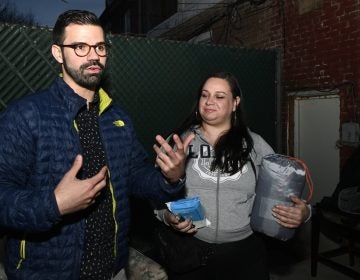Philly’s 57th Puerto Rican Day Parade a nod to indigenous ancestors’ history of perseverance
Hundreds of people participated in the 57th annual Puerto Rican Day Parade, paying homage to the first inhabitants of their island: the Taíno.

Joya Ellis participates in the 57th annual Puerto Rican Day Parade in Philadelphia. (Kriston Jae Bethel for WHYY)
Hundreds of people marched and danced their way down the Benjamin Franklin Parkway Sunday afternoon for the 57th annual Puerto Rican Day Parade, paying homage to the first inhabitants of their island: the Taíno.
The Taíno, an indigenous group native to Puerto Rico and the Caribbean, were nearly wiped out of existence because of the disease, war, and slavery that plagued them after the arrival of European colonizers in the 15th century.
El Concilio, “the oldest Latino organization in Philadelphia” which hosts the parade, said the theme, “The Taíno Warrior Within” was chosen by the public.

People observed the theme by wearing bright Taíno clothing adorned with feathers, face paint, and carrying traditional instruments like wooden gourds.
But at the heart of the parade, participants remembered all the Taíno endured during colonization and celebrated their ancestors’ strength and resilience, qualities they say have been passed through centuries — right down to Puerto Ricans in Philadelphia.
“Especially where we live at in our area, … we have to persevere and be optimistic in our daily lives to continue to go on and know there is something bigger and better for us,” said Jade McCray, a teacher at Juniata Park Academy in North Philadelphia.
McCray said many students in her part of the city face poverty and violence on a daily basis, but instead of being discouraged by their environment, she hopes they can find the strength to go on from their Taíno ancestors.
She and 12 of her students, who are all of Puerto Rican and other Caribbean heritage, tapped into their Taíno ancestry for the past two months as they prepared to perform a ritual dance at the Puerto Rican Day Parade.
One girl played the role of chief of ceremonies and reached out to the Taíno who came before her by playing specific notes on a wooden flute, McCray explained.

The rest of the girls, who wore seashell necklaces and red, white, and blue folkloric dresses, responded with wooden drums and maracas and encircled the chief.
“They begin to dance in a joyous ceremony surrounding the chief of ceremony, playing our vibrant instruments,” McCray said.
Keeping ‘la cultura’ alive
About 1,500 people participate in the march down the Parkway each year, performing in bands, drumlines, and on floats.
Another hallmark of the parade is the student performances, where groups compete for a trophy and bragging rights.
Putting together a choreographed performance for a live and televised audience of thousands takes a lot of work.

For almost 20 years, Hector Serrano’s dance company, Grupo Fuego and Caliente, taught hundreds of students different choreographies from traditional styles, such as the percussion-heavy bomba and plena, to modern hip-hop.
“This is the parade, people come to be entertained,” Serrano said. “We did cha-cha, rhumba, merengue, a little bit of everything to not only appeal to the Puerto Rican community and just all of the Latino countries.”

Preparation involved hours of rehearsals on Saturdays and evenings after school, making 600 costumes in a matter of weeks, and hosting fundraisers to pay for them.
The reason he did it all those years?
“It keeps the cultura, la cultura Puertorriqueña, it keeps it alive,” Serrano said.
This year’s parade was a much more relaxed endeavor for Serrano, who was a first-time dance judge, weighing factors like entertainment, technical skills, and how the groups adhered to the Taíno Warrior theme.
That spirit of the Taíno warrior is still important to many Puerto Ricans, who said they still have to fight for their rights in the United States and on the island.

Speakers applauded the Puerto Ricans in Philly who took to the streets just a few months ago to protest their disgraced former Gov. Ricardo Rosselló.
For Hiram Carmona, who has attended almost every parade for the past 20 years, it’s a time to display his pride, and to remember a time when Puerto Ricans couldn’t fly their flag under years of Spanish rule and when it first became a U.S. territory.

“That’s why you see Puerto Rican flags everywhere,” Carmona said. “Because what once was unlawful to display, now it shows our heart and our love for the country and our love for the flag.”
WHYY is your source for fact-based, in-depth journalism and information. As a nonprofit organization, we rely on financial support from readers like you. Please give today.





